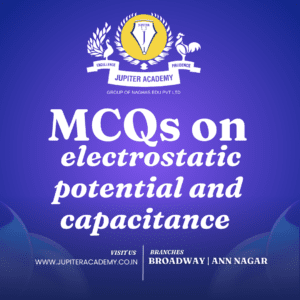NEET 2025: OMR Sheet Filling Tips to Avoid Mistakes Preparing...
Read More
MCQs on electrostatic potential & capacitance
Question 1: The electrostatic potential at a point in an electric field is 200 V. What does this indicate?
A) The magnitude of the electric field at that point B) The work done to bring a unit positive charge from infinity to that point C) The electric potential energy at that point D) The magnitude of the electric field due to a nearby charge
Answer: B) The work done to bring a unit positive charge from infinity to that point
Question 2: Two capacitors, C1 and C2, are connected in parallel. If C1 has a capacitance of 4 μF and C2 has a capacitance of 6 μF, what is the total equivalent capacitance?
A) 2 μF B) 10 μF C) 24 μF D) 8 μF
Answer: B) 10 μF
Question 3: The electric potential energy stored in a capacitor is given by:
A) U = CV B) U = 1/2 CV^2 C) U = Q^2/2C D) U = 1/2 Q^2C
Answer: D) U = 1/2 Q^2C
Question 4: A capacitor is connected to a battery. If the battery is disconnected and the distance between the plates of the capacitor is doubled, what happens to the stored energy?
A) It doubles B) It halves C) It quadruples D) It remains the same
Answer: B) It halves
Question 5: The capacitance of a parallel-plate capacitor depends on:
A) The separation between the plates B) The area of the plates C) The dielectric constant of the material between the plates D) All of the above
Answer: D) All of the above
6. The potential energy of a pair of charges is given by U = kqq/r, where k is a constant, q is the charge of each particle, and r is the distance between them. If the charge of one particle is doubled, what happens to the potential energy?
(A) It is doubled. (B) It is halved. (C) It is quadrupled. (D) It is unchanged.
Answer: (A)
The potential energy is proportional to the square of the charge. Doubling the charge will quadruple the potential energy.
7. Two charges of +10μC and -10μC are placed 10cm apart. What is the electric field at a point halfway between them?
(A) 100N/C (B) 500N/C (C) -500N/C (D) 0N/C
Answer: (C)
The electric field is directed from the positive charge to the negative charge. The magnitude of the electric field is given by E = kqq/r^2, where k is a constant, q is the charge of each particle, and r is the distance between them. In this case, r = 10cm/2 = 5cm. The electric field is therefore E = 9×10^9 N⋅m^2/C^2 * 10μC * (-10μC) / (5cm)^2 = -500N/C.
8. A parallel plate capacitor has plates of area 100cm^2 and a separation of 1mm. The capacitance of the capacitor is 10μF. What is the dielectric constant of the material between the plates?
(A) 1 (B) 10 (C) 100 (D) 1000
Answer: (C)
The capacitance of a parallel plate capacitor is given by C = ε₀A/d, where ε₀ is the permittivity of free space, A is the area of the plates, and d is the separation between the plates. The dielectric constant of a material is a measure of how much it increases the capacitance of a capacitor. In this case, the dielectric constant is ε = C/ε₀A/d = 10μF / (8.85 x 10^-12 F/m * 100cm^2 / 1mm) = 100.
9. A capacitor is charged to a potential difference of 10V. If the charge on the capacitor is 10μC, what is the capacitance of the capacitor?
(A) 1μF (B) 10μF (C) 100μF (D) 1000μF
Answer: (B)
The charge on a capacitor is given by Q = CV, where C is the capacitance of the capacitor and V is the potential difference across the capacitor. In this case, Q = 10μC and V = 10V. The capacitance is therefore C = Q/V = 10μC / 10V = 1μF.
TN Medical 2024 Counseling: Extension of Round 2 for MBBS & BDS
TN Medical 2024 Counseling: Extension of Round 2 for MBBS...
Read MoreTENTATIVE ROUND-II COUNSELLING SCHEDULE FOR ADMISSION TO MBBS/BDS
Registration Starts from 11-09-2024 10:00 A.M to 13-09-2024 05:00 P.M....
Read MoreMCQs on electrostatic potential & capacitance MCQs on electrostatic potential & capacitance MCQs on electrostatic potential & capacitance MCQs on electrostatic potential & capacitance MCQs on electrostatic potential & capacitance MCQs on electrostatic potential & capacitance MCQs on electrostatic potential & capacitance MCQs on electrostatic potential & capacitance MCQs on electrostatic potential & capacitance MCQs on electrostatic potential & capacitance MCQs on electrostatic potential & capacitance





